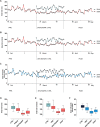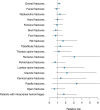Impact of the COVID-19 shutdown on orthopedic trauma numbers and patterns in an academic Level I Trauma Center in Berlin, Germany
- PMID: 33592046
- PMCID: PMC7886210
- DOI: 10.1371/journal.pone.0246956
Impact of the COVID-19 shutdown on orthopedic trauma numbers and patterns in an academic Level I Trauma Center in Berlin, Germany
Abstract
Background: The COVID-19 pandemic led to the implementation of drastic shutdown measures worldwide. While quarantine, self-isolation and shutdown laws helped to effectively contain and control the spread of SARS-CoV-2, the impact of COVID-19 shutdowns on trauma care in emergency departments (EDs) remains elusive.
Methods: All ED patient records from the 35-day COVID-19 shutdown (SHUTDOWN) period were retrospectively compared to a calendar-matched control period in 2019 (CTRL) as well as to a pre (PRE)- and post (POST)-shutdown period in an academic Level I Trauma Center in Berlin, Germany. Total patient and orthopedic trauma cases and contacts as well as trauma causes and injury patterns were evaluated during respective periods regarding absolute numbers, incidence rate ratios (IRRs) and risk ratios (RRs).
Findings: Daily total patient cases (SHUTDOWN vs. CTRL, 106.94 vs. 167.54) and orthopedic trauma cases (SHUTDOWN vs. CTRL, 30.91 vs. 52.06) decreased during the SHUTDOWN compared to the CTRL period with IRRs of 0.64 and 0.59. While absolute numbers decreased for most trauma causes during the SHUTDOWN period, we observed increased incidence proportions of household injuries and bicycle accidents with RRs of 1.31 and 1.68 respectively. An RR of 2.41 was observed for injuries due to domestic violence. We further recorded increased incidence proportions of acute and regular substance abuse during the SHUTDOWN period with RRs of 1.63 and 3.22, respectively.
Conclusions: While we observed a relevant decrease in total patient cases, relative proportions of specific trauma causes and injury patterns increased during the COVID-19 shutdown in Berlin, Germany. As government programs offered prompt financial aid during the pandemic to individuals and businesses, additional social support may be considered for vulnerable domestic environments.
Conflict of interest statement
The authors have declared that no competing interests exist.
Figures





Similar articles
-
Impact of the first COVID-19 shutdown on patient volumes and surgical procedures of a Level I trauma center.Eur J Trauma Emerg Surg. 2021 Jun;47(3):665-675. doi: 10.1007/s00068-021-01654-8. Epub 2021 Apr 21. Eur J Trauma Emerg Surg. 2021. PMID: 33881555 Free PMC article.
-
The impact of the SARS-CoV-2 pandemic-related lockdowns on orthopedic trauma emergencies at a level-one trauma center.Arch Orthop Trauma Surg. 2023 Oct;143(10):6201-6208. doi: 10.1007/s00402-023-04947-2. Epub 2023 Jun 21. Arch Orthop Trauma Surg. 2023. PMID: 37341804 Free PMC article.
-
Knee Surgery during the COVID-19 Lockdown-Experiences of a Level-One Trauma Center in Germany.Biomed Res Int. 2021 May 25;2021:8875643. doi: 10.1155/2021/8875643. eCollection 2021. Biomed Res Int. 2021. PMID: 34189140 Free PMC article. Clinical Trial.
-
Effect of Quarantine and Reopening Measures on Pediatric Trauma Admissions During the 2019 SARS-CoV2 Virus Pandemic.J Am Coll Surg. 2022 Apr 1;234(4):685-690. doi: 10.1097/XCS.0000000000000130. J Am Coll Surg. 2022. PMID: 35290289
-
Travel-related control measures to contain the COVID-19 pandemic: a rapid review.Cochrane Database Syst Rev. 2020 Oct 5;10:CD013717. doi: 10.1002/14651858.CD013717. Cochrane Database Syst Rev. 2020. Update in: Cochrane Database Syst Rev. 2021 Mar 25;3:CD013717. doi: 10.1002/14651858.CD013717.pub2. PMID: 33502002 Updated.
Cited by
-
COVID-19 Pandemic Impact on Orthopaedic Trauma Practice: A Global Perspective.Orthop Res Rev. 2022 Jan 25;14:9-15. doi: 10.2147/ORR.S345301. eCollection 2022. Orthop Res Rev. 2022. PMID: 35115847 Free PMC article. Review.
-
The Effects of the COVID-19 Pandemic on the Pattern of Fractures in Taif City, Saudi Arabia.Cureus. 2024 Apr 5;16(4):e57680. doi: 10.7759/cureus.57680. eCollection 2024 Apr. Cureus. 2024. PMID: 38707121 Free PMC article.
-
Excess mortality after hip fracture during COVID-19 pandemic: More about disruption, less about virulence-Lesson from a trauma center.PLoS One. 2022 Feb 25;17(2):e0263680. doi: 10.1371/journal.pone.0263680. eCollection 2022. PLoS One. 2022. PMID: 35213561 Free PMC article.
-
The Hidden Pandemic: Impact of the COVID-19 Pandemic on Trauma Cases Due to Domestic Violence Admitted to the Biggest Level-One Trauma Center in Austria.J Clin Med. 2023 Dec 31;13(1):246. doi: 10.3390/jcm13010246. J Clin Med. 2023. PMID: 38202253 Free PMC article.
-
Factors affecting 30-day postoperative complications after emergency surgery during the COVID-19 outbreak: A multicentre cohort study.Int J Surg Open. 2021 Sep;35:100397. doi: 10.1016/j.ijso.2021.100397. Epub 2021 Aug 24. Int J Surg Open. 2021. PMID: 34568624 Free PMC article.
References
MeSH terms
LinkOut - more resources
Full Text Sources
Other Literature Sources
Medical
Research Materials
Miscellaneous

